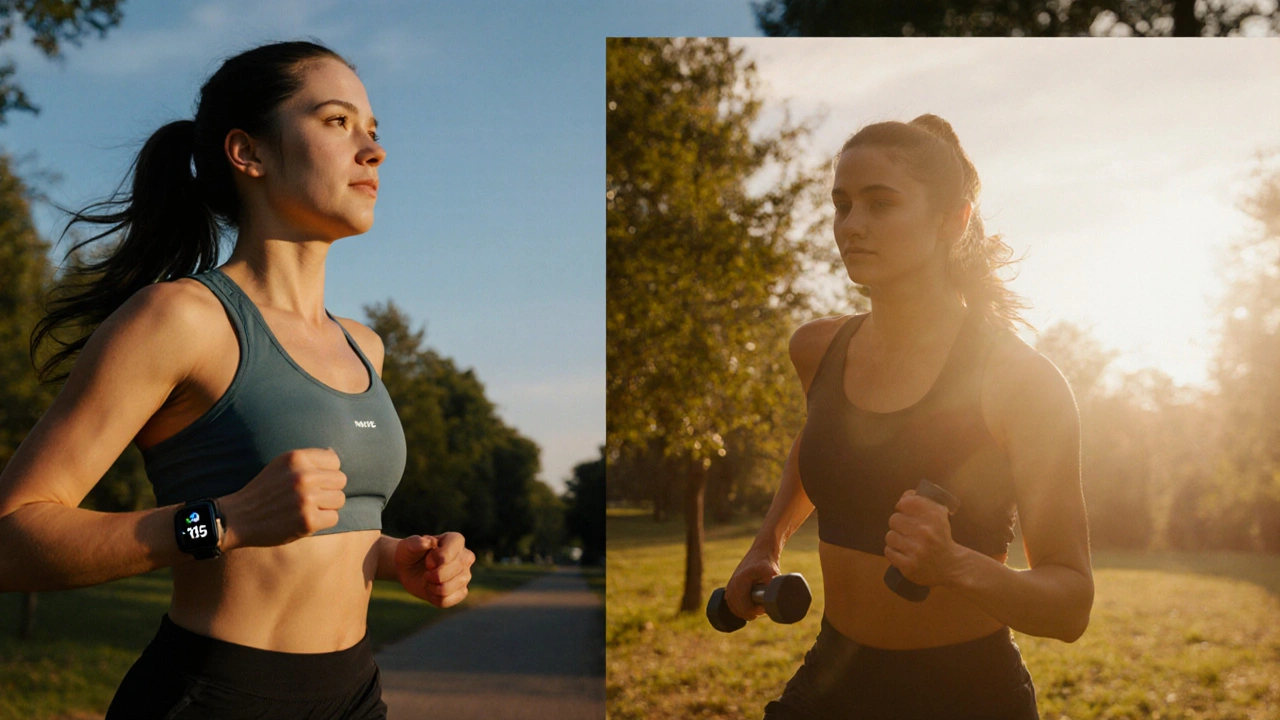Breast Cancer Risk Assessment Tool
Physical Activity
Regular exercise lowers estrogen and boosts immunity.
Body Weight
Maintaining a healthy BMI reduces inflammation.
Alcohol Consumption
Limiting intake cuts estrogen-raising chemicals.
Dietary Patterns
Plant-rich diets supply fiber and antioxidants.
Tobacco Use
Smoking introduces carcinogens affecting breast tissue.
Vitamin D Levels
Adequate sun exposure supports cell regulation.
Hormone Therapy
Careful use avoids unnecessary hormone exposure.
Screening Practices
Regular mammograms catch tumors early.
Your Breast Cancer Risk Assessment
Key Recommendations:
When it comes to reducing the chance of developing breast cancer, the choices you make every day add up. By tweaking diet, activity, and a few everyday habits, you can shift the odds in your favor without expensive medical interventions.
Breast Cancer Prevention is a proactive approach that combines evidence‑based lifestyle adjustments, regular screening, and informed medical decisions to lower the probability of breast cancer developing.Why Lifestyle Matters
Research from major cancer institutes shows that up to 30% of breast cancer cases are linked to modifiable factors. That means a significant slice of risk can be managed through everyday behavior rather than waiting for symptoms.
Breast Cancer is a malignant disease that originates in the cells of the breast, and it remains one of the most common cancers among women worldwide.Key Lifestyle Factors That Influence Risk
Below are the eight most influential habits, ranked by the strength of scientific evidence. Each factor can be tracked with simple tools like a phone app or a weekly journal.
- Physical Activity - regular exercise lowers estrogen levels and improves immune function.
- Body Weight - maintaining a healthy BMI reduces inflammation.
- Alcohol Consumption - limiting intake cuts down on estrogen‑raising chemicals.
- Dietary Patterns - a plant‑rich diet supplies fiber and antioxidants.
- Tobacco Use - smoking introduces carcinogens that can affect breast tissue.
- Hormone Therapy - careful use of menopausal hormones can avoid unnecessary exposure.
- Vitamin D Levels - adequate sun exposure or supplementation supports cell regulation.
- Early Detection Practices - regular mammograms catch tumors before they spread.

Physical Activity: Move to Reduce
Moderate‑intensity aerobic exercise-think brisk walking, cycling, or swimming-aimed at 150 minutes per week is the sweet spot. Strength training twice a week adds muscle mass, which helps keep insulin stable, a factor linked to lower breast cancer risk.
Physical Activity refers to any bodily movement produced by skeletal muscles that requires energy expenditure, such as walking, jogging, or resistance training.Real‑world tip: set a recurring calendar reminder titled “Move‑15” that prompts a 15‑minute walk after lunch. Over a month, you’ll hit the weekly target without feeling it’s a chore.
Weight Management and Body Mass Index (BMI)
Higher body fat, especially after menopause, leads to increased estrogen production from adipose tissue. A BMI between 18.5 and 24.9 is associated with the lowest risk.
Body Mass Index is a calculated value (weight in kilograms divided by height in meters squared) used to categorize underweight, normal weight, overweight, and obesity.Track your weight weekly using a bathroom scale that syncs to a health app. Notice trends before they become problems.
Alcohol & Smoking: The Dual Threat
Each standard drink (≈12g of alcohol) raises breast cancer risk by about 7%. The safest approach is to stay under one drink per day, or better yet, abstain.
Alcohol Consumption is the intake of beverages containing ethanol, such as wine, beer, and spirits, measured in standard drinks.Smoking adds a layer of DNA damage. Even occasional smoking increases risk, so consider nicotine‑replacement tools if quitting feels daunting.
Smoking is the inhalation of tobacco smoke, delivering carcinogenic compounds that can affect breast tissue as well as lungs.
Nutrition: Eat the Right Foods
Evidence points to a Mediterranean‑style diet-high in fruits, vegetables, whole grains, legumes, nuts, and olive oil-as protective. Specific components to focus on:
- Fiber≥25g/day (found in beans, oats, berries)
- Cruciferous vegetables like broccoli and kale (contain sulforaphane)
- Healthy fats from nuts and avocado (replace saturated fats)
- Limited red meat and processed meats
A practical swap: replace a daily sugary snack with a handful of almonds and an apple. The combo provides fiber, protein, and healthy fats, keeping insulin steady.
Hormone Therapy and Medication Choices
Combined estrogen‑progestin hormone replacement therapy (HRT) has been linked to a 20% higher breast cancer risk. If relief from menopausal symptoms is needed, discuss low‑dose or bioidentical options with your doctor.
Hormone Therapy refers to the medical use of estrogen and/or progestin to treat menopausal symptoms, which can affect breast cancer risk depending on formulation and duration.Never start HRT without a personalized risk assessment that includes family history and prior breast biopsies.
Vitamin D and Sunlight
Observational studies suggest that circulating vitaminD levels above 30ng/mL are associated with a modest risk reduction. Aim for 10-15minutes of midday sun a few times a week, or consider a 1000-2000IU supplement after checking blood levels.
Vitamin D is a fat‑soluble vitamin that helps regulate calcium metabolism and may influence cell growth in breast tissue.
Early Detection: The Complementary Pillar
Even with perfect lifestyle habits, regular screening remains crucial. For women aged 40-49, annual mammograms are increasingly recommended, especially if there’s a family history.
Mammography is an X‑ray imaging technique used to detect early‑stage breast tumors, often before they can be felt.Combine self‑exams with professional imaging to catch abnormalities early.
Putting It All Together: A Quick‑Start Checklist
- Log 150 minutes of moderate‑intensity exercise each week.
- Maintain BMI between 18.5‑24.9; weigh yourself weekly.
- Limit alcohol to ≤1 drink per day; consider alcohol‑free days.
- Quit smoking; use cessation aids if needed.
- Adopt a Mediterranean diet: ≥5 servings of fruits/veg, 2+servings of whole grains daily.
- Check vitaminD levels annually; supplement if <30ng/mL.
- Discuss any hormone therapy with your doctor; opt for lowest effective dose.
- Schedule mammograms according to age‑based guidelines; keep a reminder.
Following these steps consistently can shave years off your estimated risk profile, offering peace of mind and better overall health.
Frequently Asked Questions
Can a single lifestyle change make a big difference?
Yes. Studies show that just adding 30 minutes of brisk walking five days a week can lower estrogen levels enough to reduce risk by about 10% over a decade.
Is breast cancer risk the same for all ethnic groups?
Risk varies. For example, women of Ashkenazi Jewish descent have a higher prevalence of BRCA mutations, while Asian populations generally show lower incidence, partly due to dietary patterns.
How accurate are self‑breast exams compared to mammograms?
Self‑exams help you become familiar with your own tissue, but mammography detects tumors that are not yet palpable. Both are valuable; use them together.
Does drinking coffee affect breast cancer risk?
Current evidence suggests moderate coffee intake (1‑3 cups per day) does not increase risk and may even offer a small protective effect due to antioxidants.
What role does genetics play if I follow a healthy lifestyle?
Genetic predisposition (e.g., BRCA1/2 mutations) can raise baseline risk, but lifestyle choices still modify the absolute risk. Even high‑risk women benefit from weight control, exercise, and limited alcohol.
By weaving these evidence‑backed habits into daily life, you empower yourself with a practical, affordable strategy for breast cancer prevention. Start small, track progress, and let each positive change add up to a healthier future.


Comments (13)
Adam Craddock
Recent epidemiological studies have quantified the impact of modifiable risk factors on breast cancer incidence, indicating that approximately one‑third of cases can be attributed to lifestyle choices. Regular aerobic exercise, defined as a minimum of 150 minutes per week, has been consistently associated with a reduction in circulating estrogen levels, which in turn mitigates mitogenic stimulation of breast tissue. Maintaining a body mass index within the 18.5‑24.9 range further attenuates inflammatory pathways that are implicated in tumorigenesis. Alcohol consumption, even at modest levels, introduces acetaldehyde metabolites that exert estrogenic effects, thereby elevating risk. A diet rich in phytochemicals-particularly cruciferous vegetables and soluble fiber-provides antioxidant protection and improves insulin sensitivity, both of which are protective against oncogenic processes. Tobacco smoke delivers polycyclic aromatic hydrocarbons that directly damage DNA, emphasizing the necessity of cessation. Vitamin D sufficiency, commonly assessed via serum 25‑hydroxy levels above 30 ng/mL, supports cellular differentiation and may reduce malignant transformation. Finally, adherence to established mammography schedules enables early detection, substantially improving prognostic outcomes. Integrating these evidence‑based measures constitutes a comprehensive prevention strategy.
michael klinger
What the mainstream media won’t tell you is that the pharmaceutical industry has a vested interest in keeping us dependent on costly treatments rather than empowering us with simple, free lifestyle changes. The push for hormone replacement therapy, for instance, is heavily funded by drug manufacturers who profit from the ensuing increase in breast cancer cases. Meanwhile, public health campaigns quietly celebrate a modest reduction in risk from exercise while ignoring the systemic barriers that prevent many from accessing safe spaces to work out. Even the guidelines on vitamin D supplementation are riddled with conflicts of interest, as supplement companies lobby to keep the recommended thresholds artificially low. In short, the narrative that “you can prevent cancer by walking more” is a convenient distraction from the profit‑driven agenda that benefits from disease prevalence.
Carys Jones
It is a moral imperative to hold ourselves accountable for the choices that shape our health, especially when those choices affect our families and future generations. Embracing a plant‑based diet, discarding the glorification of binge drinking, and refusing to indulge in tobacco are not merely personal preferences; they are ethical commitments to reduce the burden of suffering. To continue excusing excessive alcohol consumption as “socially acceptable” while ignoring its proven carcinogenic link is an affront to common decency. Likewise, praising hormone therapy without acknowledging its elevated risk betrays a careless disregard for informed consent. Let us demand honesty, reject complacency, and champion the lifestyle practices that demonstrably lower breast cancer risk.
Roxanne Porter
Integrating these recommendations into daily routines can be approached collaboratively. For example, families might schedule a weekly walk after dinner, turning exercise into a shared activity that also strengthens relationships. Meal planning sessions can focus on incorporating at least five servings of fruits and vegetables, ensuring that nutritional goals are met without imposing restrictions on individual preferences. Support groups for smoking cessation provide accountability and resources, making the transition away from tobacco more manageable. By aligning personal health objectives with community support, the implementation of preventive measures becomes both feasible and sustainable.
Jonathan Mbulakey
When we look at health through a broader lens, the choice to move more, eat better, and avoid harmful substances feels like an exercise in personal agency. It's a subtle negotiation with our bodies, balancing immediate comfort against long‑term wellbeing. The notion that a simple habit, like a 15‑minute walk after meals, can ripple through hormonal pathways and reduce cancer risk is a reminder that complexity often hides in plain sight. Ultimately, each small decision contributes to a larger narrative about who we are and how we choose to live.
Warren Neufeld
Lots of research shows that staying active, keeping a healthy weight, and cutting down on alcohol can really help lower the chance of getting breast cancer. Eating more fruits and veggies, quitting smoking, and getting enough vitamin D are also good steps. Regular check‑ups and mammograms catch problems early, making treatment easier. Little changes add up, so it’s worth trying to include a few healthy habits each day.
Deborah Escobedo
Start small and build momentum. A short walk after lunch adds up to the weekly 150‑minute goal. Swap one sugary snack for an apple and a handful of nuts to boost fiber and healthy fats. If you smoke, consider nicotine patches or gum-they can ease the transition. Aim for at least five servings of fruits or vegetables each day; frozen options work just as well as fresh. Check your vitamin D level during a routine blood test and talk to your doctor about safe sun exposure or a supplement if needed. Finally, schedule your mammogram according to the guidelines for your age group. These steps are simple, affordable, and can make a difference.
Vanessa Peters
Adam’s list of lifestyle hacks reads like a corporate wellness brochure, glossing over the gritty reality that most people cannot simply “maintain a BMI” without confronting food deserts and predatory marketing of ultra‑processed snacks. The suggestion to “exercise 150 minutes per week” assumes you have safe neighborhoods, free time, and a body unburdened by chronic pain-luxuries unavailable to the working poor. Moreover, the emphasis on “moderate alcohol” fails to account for the cultural pressures that normalize binge drinking in social settings, turning a “limit” into a near‑impossible goal. The claim that “vitamin D supplementation” is a simple fix ignores the profit margins of supplement giants who flood the market with overpriced pills while keeping the public misinformed about optimal sun exposure. Even the endorsement of “regular mammograms” sidesteps the fact that screening facilities are unevenly distributed, with rural areas facing long travel distances and long wait times. These recommendations collectively serve as a veneer of empowerment while the underlying structural inequities remain unaddressed. It is a classic case of victim‑blaming, where the onus of disease prevention is shifted onto individuals rather than the systems that produce risk. The narrative also conveniently omits the role of corporate lobbying in shaping dietary guidelines, ensuring that certain food industries remain protected. While the tone is encouraging, the reality is that many of these “simple changes” require resources-time, money, and access-that are systematically denied to marginalized communities. In turn, this perpetuates a cycle where disease prevalence continues to fuel the healthcare industry’s profit engines. The result is a paradox: the very advice meant to reduce incidence ends up reinforcing the socioeconomic determinants of health that drive it. Therefore, a critical examination of these lifestyle prescriptions reveals a deeper agenda that prioritizes market stability over genuine public health advancement. Healthcare policymakers must confront these disparities rather than passively accept them as unavoidable. Only by reallocating funding toward community health initiatives can we hope to level the playing field. Otherwise, the cycle of blame and profit will persist indefinitely. In short, lifestyle advice without systemic reform is a hollow promise. We need to demand accountability from both industry and government to truly lower breast cancer risk.
Suzan Graafstra
One might argue that the moral outrage Carys expresses is itself a product of cultural conditioning, a manifestation of the very societal structures she seeks to dismantle. The binary of “ethical” versus “unethical” food choices simplifies a complex web of agricultural practices, labor exploitation, and environmental impact. Thus, the pursuit of a “pure” lifestyle becomes a philosophical mirage, an ideal that forever recedes as we interrogate the foundations of our consumption. Yet, in embracing this paradox, we may find a deeper humility that guides more compassionate choices.
Kripa Mohamed
Look, you’re just waxing philosophical while people are dying because they can’t afford a gym membership. The big pharma lobby pushes the idea that you need expensive supplements to “balance” your vitamin D, keeping the poor stuck in a cycle of dependence. And don’t get me started on how the “healthy” food industry markets junk as “organic” to keep us buying more. It’s a sick game, and pretending that a walk after lunch will save lives is naive.
Troy Freund
Vanessa’s point about accessibility hits home-so does the need for community‑driven solutions. What if neighborhoods organized free walking groups, using parks or schoolyards as meeting spots? Pair that with a local farmer’s market day where residents can grab affordable produce, maybe even get a discount with a “healthy habit” pledge. Small collective actions can chip away at the barriers Kripa mentions, turning philosophy into tangible momentum.
lucy kindseth
Try a “meat‑free Monday” to boost your veg intake without overhauling your whole diet.
Nymia Jones
Mr. Klinger’s insinuations regarding pharmaceutical motives, while not entirely unfounded, overlook the rigorous peer‑review processes that govern clinical guidelines. Nonetheless, it is incumbent upon the informed public to demand full transparency regarding funding sources and potential conflicts of interest that may color recommendations. The assertion that hormone replacement therapy is merely a profit‑driven ploy fails to acknowledge nuanced risk‑benefit analyses conducted by independent bodies. Therefore, I assert that a balanced discourse, grounded in verifiable data, is essential to dispel misinformation and to uphold the integrity of preventive health strategies.